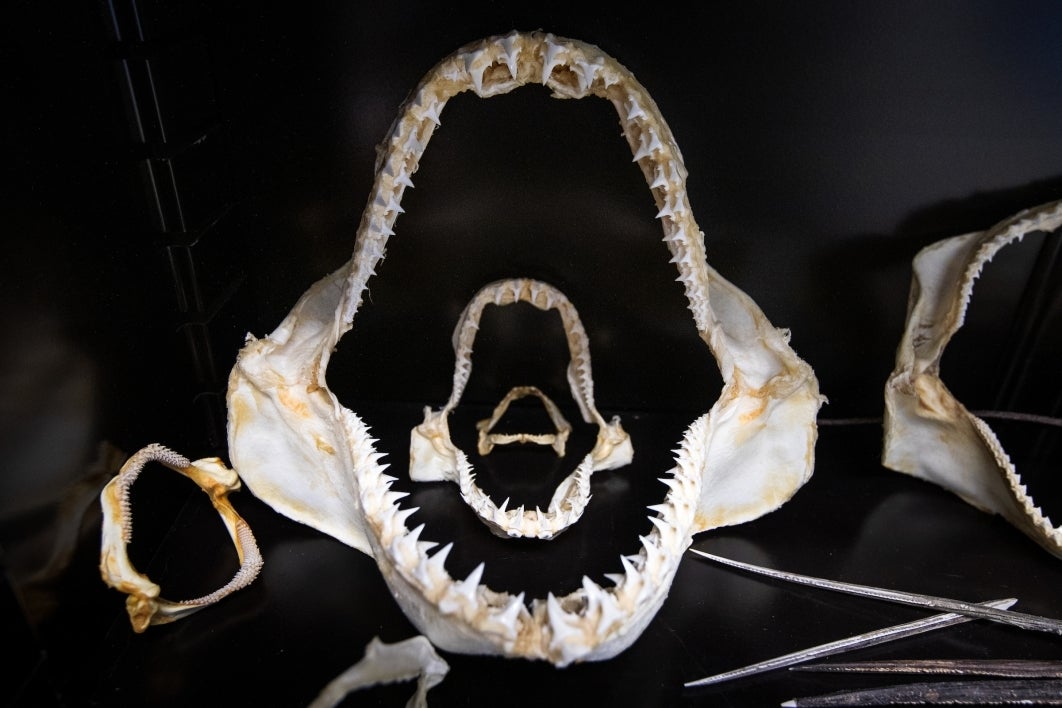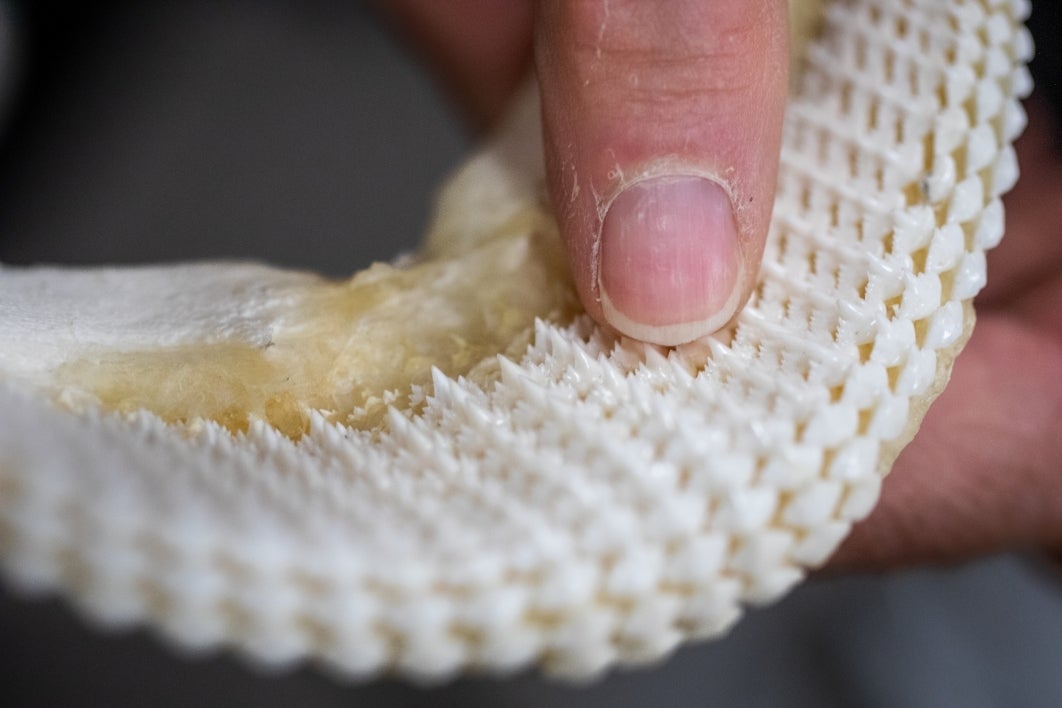This summer, when James Sulikowski announced on Twitter that he was moving his Shark and Fish Conservation Lab from the University of New England to Arizona State University’s New College of Interdisciplinary Arts and Sciences, he left a lot of people scratching their heads.
Why would an internationally recognized marine life expert move from a prime coastal location to the middle of the Sonoran Desert to expand his research lab?
“There’s this land shark that nobody knows about,” Sulikowski said. “It's one of those great mysteries I'm trying to solve.”
He’s kidding, of course. (We hope.)
“Arizona State is an amazing university and the way in which they go about their mission and the opportunities available here are things that I was really interested in being part of,” he said. “So it might seem crazy but my research takes me everywhere — I do work in New England, the Bahamas, the Gulf of Mexico, I collaborate with individuals in Canada — so this is just another geographical location for me.”
Sulikowski, who assumed his new post as professor and associate director of New College’s School of Mathematical and Natural Sciences in August, hopes to add some of Arizona’s many freshwater offerings, as well as John Steinbeck’s fabled Sea of Cortez that separates the Baja California Peninsula from mainland Mexico to that list of locations during his tenure here.
In 25 years as a marine biologist, Sulikowski has caught, tagged and tracked aquatic life as diverse as the cunning anglerfish, the lucrative scallop and his current favorite, the porbeagle, a cousin of the infamous great white shark. He’s been bitten by sharks a total of three times but he doesn’t hold a grudge.
“We are not on their menu,” he said. Most shark bites are either accidental or cases of mistaken identity that go south because, yes, their teeth are very sharp and they can do a lot of damage very quickly. That’s because throughout their lives, sharks’ teeth are constantly falling out and being replaced by new ones, like some sort of conveyor belt of freshly sharpened mouth daggers.
“Oftentimes the sharks that do bite people are relatively small and they're just going up to see what it is and then realizing it’s not what they want and then leaving,” Sulikowski said. “But even if its teeth are just touching you. … We’re like the warm butter and their teeth are like the hot knife. But it’s not a premeditated thing.”
He points out that globally, there are only about 150 human-shark encounters per year (the University of Florida’s 2018 International Shark Attack File puts that number even lower, at 130 alleged incidents of human-shark interaction), yet roughly 400 million people go swimming in the ocean off the coast of Florida alone every year. If you’re still worried, he suggests avoiding known hot spots like Cape Cod and the Cape of Good Hope off the coast of Africa, and avoiding certain behavior like swimming at dusk or dawn, swimming near seal colonies or wearing shiny things that mimic fish scales.
Sulikowski actually is more worried about drowning in the ocean than he is of sharks.
“In all of our outreach we try to impress a consciousness about how important sharks are to the ecosystem and that they're a lot more afraid of us than we should be of them,” he said.
When Sulikowski was a child, his family lived for a brief period of time in San Antonio. One of his earliest memories is of a day at the beach on the Gulf of Mexico when he happened upon a lifeless shark that had washed ashore. Far from frightening, the experience invigorated the young Sulikowski, sparking a lifelong fascination.
After earning his doctorate in zoology from the University of New Hampshire in 2003, Sulikowski began teaching there and later added a professorship at the University of New England to his resume in 2006. There, he founded the Sulikowski Shark and Fish Conservation Lab, and it wasn’t long before shows like National Geographic’s “Ocean Mysteries with Jeff Corwin” and the BBC’s “Rise of Animals” came knocking.
Over the summer, Sulikowski filmed his third appearance on the Discovery Channel’s wildly popular “Shark Week.” He is greatly appreciative of the opportunity such outlets afford him to share his work with broad audiences but has learned to be selective. One show recorded him and his team using cutting-edge technology to perform ultrasounds on tiger sharks, then later spliced in bogus footage of cartoonish baby tiger sharks going ballistic in the womb.
“Now we understand how these shows work and we stay away from the ones that are more hokey and stick to the ones that are scientific and that can provide great facts to people to get them interested in how they can help with conservation and being environmentally conscious,” he said.
Much of Sulikowski’s research efforts are focused on maintaining sustainable fishing ecosystems, so he works closely with commercial and recreational fishing industries and federal agencies to develop better handling techniques and identify areas where fishing should be avoided at certain times of the year.
To do that, he and his research team use a suite of technologies to track a variety of fish in a variety of locations. A typical expedition on the water lasts anywhere from one to two weeks, during which time they catch, measure and tag anywhere from 10 to 15 fish. Over the next year, data regarding the fish’s location is transmitted back to Sulikowski’s lab in real time. Using that data, his team can glean such insights as how fish population distributions and biological characteristics are affected by environmental factors like fishing industry and warming ocean waters.
“Those are things that are really important to us to understand, and because the environment's changing so quickly, research that was conducted over the last 10 to 15 years all needs to be redone,” Sulikowski said. “So it's an exciting time but it’s also a daunting time.”
Because sustainability is an important aspect of his work, Sulikowski aspires to using noninvasive and nonlethal methods of data collection in his lab. So for fish whose populations are endangered or threatened, they take blood samples or perform ultrasounds instead of sacrificing the fish.
Student involvement in research is also important to him. Recently, a group of his students took a boat out off the coast of Maine and ended up finding and tagging a thresher shark.
“Finding a thresher shark is like finding a needle in a haystack; it’s a gold mine,” he said. “And for students to be able to see that is absolutely incredible. One of my goals is to train the next generation (of researchers), and the way you train the next generation is you give them hands-on experiences.”
Not every outing is uplifting, though. In early July of this year, Sulikowski and his team found a female porbeagle with a ring of plastic embedded around her neck. If they hadn’t caught her when they did and removed the ring, he said, there is no doubt it would have eventually decapitated her.
They named the shark Destiny, and she is now transmitting location data “like a true champ.” It was a satisfying victory considering porbeagle populations are threatened globally, endangered in Canadian waters and on the cusp of endangerment in U.S. waters.
Looking toward his future in Arizona, Sulikowski is eager to begin exploring the abundant anglerfish populations and hopes to collaborate on that work with entities like the Arizona Game and Fish Department.
“Not many people know this, but it's like a billion dollar industry here,” he said.
With an estimated 1 million anglerfish to start tracking, he’s got his work cut out for him. Thankfully, he knows he’ll have plenty of help along the way.
“Our mission and goals as a research lab fit really well with what Arizona State is all about,” Sulikowski said. “I know there are other faculty who are doing similar work and asking other kinds of questions here, which is really cool because if you can get multiple people working on multiple different questions, you can really get a good understanding of how you can make a resource sustainable. And we need to do that now because if we don't take a proactive look at it, we can do a lot of damage to ecosystems and species.”
Top photo: ASU Professor James Sulikowski poses with the jaw of a bull shark. Photo by Charlie Leight/ASU Now
More Science and technology

ASU professor honored with prestigious award for being a cybersecurity trailblazer
At first, he thought it was a drill.On Sept. 11, 2001, Gail-Joon Ahn sat in a conference room in Fort Meade, Maryland. The cybersecurity researcher was part of a group that had been invited…

Training stellar students to secure semiconductors
In the wetlands of King’s Bay, Georgia, the sail of a nuclear-powered Trident II Submarine laden with sophisticated computer equipment juts out of the marshy waters. In a medical center, a cardiac…

ASU startup Crystal Sonic wins Natcast pitch competition
Crystal Sonic, an Arizona State University startup, won first place and $25,000 at the 2024 Natcast Startup Pitch Competition at the National Semiconductor Technology Center Symposium, or NSTC…



